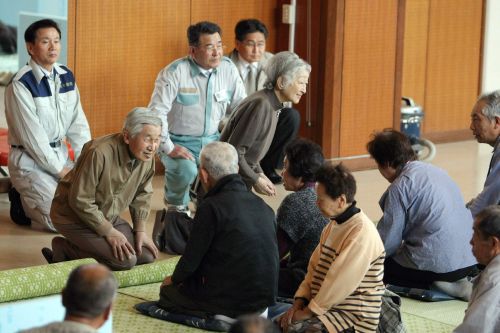TEPCO to give money to residents unable to return to homes near nuclear plant
TOKYO (AP) ― Japan’s government Friday ordered the operator of a tsunami-damaged nuclear plant leaking radiation to pay about $12,000 to each household forced to evacuate from the area.
Tens of thousands of residents unable to return to their homes near the nuclear plant are bereft of their livelihoods and possessions, unsure of when, if ever, they will be able to return home. Some have traveled hundreds of kilometers to Tokyo Electric Power Co.’s headquarters in Tokyo to press their demands for compensation.
Hiroaki Wada, a Trade Ministry spokesman, said Friday that TEPCO will pay compensation as soon as possible, with families forced to evacuate getting 1 million yen (about $12,000) and individuals getting 750,000 yen (about $9,000).
“There are around 150 evacuation centers alone. It will take some time until everyone gets money. But we want the company to quickly do this to support people’s lives,” Trade Minister Banri Kaieda said at a news conference.
The arrangement is a provisional one, with more compensation expected, Wada said. Roughly 48,000 households living within about 30 kilometers of the crippled Fukushima Daiichi nuclear plant would be eligible for the payments.
TEPCO’s president, Masataka Shimizu, was expected to formally announce the plan later Friday. The company is still struggling to stabilize the nuclear plant, which saw its cooling systems fail after a magnitude 9.0 earthquake on March 11 triggered a massive tsunami that wrecked emergency backup systems as well as much of the plant’s regular equipment.
TOKYO (AP) ― Japan’s government Friday ordered the operator of a tsunami-damaged nuclear plant leaking radiation to pay about $12,000 to each household forced to evacuate from the area.
Tens of thousands of residents unable to return to their homes near the nuclear plant are bereft of their livelihoods and possessions, unsure of when, if ever, they will be able to return home. Some have traveled hundreds of kilometers to Tokyo Electric Power Co.’s headquarters in Tokyo to press their demands for compensation.
Hiroaki Wada, a Trade Ministry spokesman, said Friday that TEPCO will pay compensation as soon as possible, with families forced to evacuate getting 1 million yen (about $12,000) and individuals getting 750,000 yen (about $9,000).
“There are around 150 evacuation centers alone. It will take some time until everyone gets money. But we want the company to quickly do this to support people’s lives,” Trade Minister Banri Kaieda said at a news conference.
The arrangement is a provisional one, with more compensation expected, Wada said. Roughly 48,000 households living within about 30 kilometers of the crippled Fukushima Daiichi nuclear plant would be eligible for the payments.
TEPCO’s president, Masataka Shimizu, was expected to formally announce the plan later Friday. The company is still struggling to stabilize the nuclear plant, which saw its cooling systems fail after a magnitude 9.0 earthquake on March 11 triggered a massive tsunami that wrecked emergency backup systems as well as much of the plant’s regular equipment.

Radiation leaks from the crisis have contaminated crops and left fishermen in the region unable to sell their catches, a huge blow to an area heavily dependent on fishing and farming.
The governor of Fukushima, Yuhei Sato, has vigorously criticized both TEPCO and the government for their handling of the disaster, demanding faster action.
“This is just a beginning. The accident has not ended. We will continue to ask the government and TEPCO to fully compensate evacuees.”
Nearly 140,000 people are still living in shelters after losing their homes or being advised to evacuate because of concerns about radiation.
Seeking to console evacuees, Japan’s emperor visited the country’s disaster zone for the first time Thursday.
In Asahi, where 13 people were killed and some 3,000 homes damaged, Emperor Akihito, 77, and Empress Michiko got their first look at the devastation, somberly gazing at a plot of land where a home once stood and also commiserating with evacuees at two shelters.
The royal couple kneeled on mats to speak quietly with the survivors, who bowed in gratitude and wiped away tears. One evacuee with Down syndrome, who has trouble speaking, wrote “I will keep striving” in a small notebook that he showed to the emperor and empress. Asahi is about 85 kilometers east of Tokyo.
Even as the month-old emergency dragged on, radiation levels dropped enough for police sealed in white protective suits, goggles and blue gloves to begin searching for bodies amid the muddy debris inside a 10-kilometer radius around the Fukushima Daiichi plant that had been off-limits.
Authorities believe up to 1,000 bodies are lodged in the debris.
A police spokesman, who gave only the surname Sato, said searchers were working Friday to recover three of the 10 bodies they located Thursday that were trapped in cars or debris.
Overall, the bodies of only about 13,500 of the more than 26,000 people believed killed in the March 11 disaster have been recovered, with most thought to have been washed out to sea.



















![[Today’s K-pop] BTS pop-up event to come to Seoul](http://res.heraldm.com/phpwas/restmb_idxmake.php?idx=642&simg=/content/image/2024/04/17/20240417050734_0.jpg&u=)